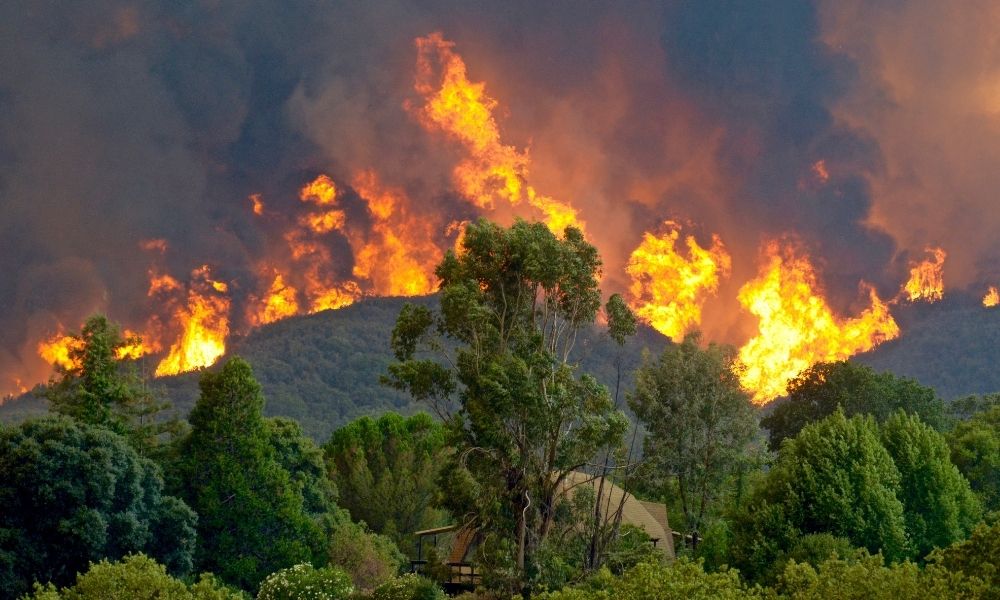Bambi Bucket

- 27 Apr 2024
Why is it in the News?
Recently, an Indian Air Force MI 17 V5 helicopter, equipped with a Bambi Bucket, was deployed to combat the forest fires in Nainital district, Uttarakhand.
What is a Bambi Bucket?
- Bambi Bucket is a specialised aerial firefighting tool that has been in use since the 1980s.
- It is essentially a lightweight collapsible container that releases water from underneath a helicopter to targeted areas.
- The water is released by using a pilot-controlled valve.
- One of its key features is that it can be quickly and easily filled.
- The bucket can be filled from various sources, including a lake, river, pond, and swimming pool, which allows firefighters to swiftly refill it and return to the target area.
- Bambi Bucket is available in a variety of sizes and models, with capacities ranging from 270 liters to more than 9,840 liters.
How was the Bambi Bucket Invented?
- The Bambi Bucket was invented by Don Arney, a Canadian business, in 1982.
- Arney came up with the idea after he realised that the aerial firefighting water buckets in use at the time were not efficient and had a high failure rate.
- These water buckets were generally made of “solid fiberglass, plastic, or canvas with metal frames” and were “too rigid to fit inside the aircraft” and had to be “trucked to fire sites or flown in on the hook of a helicopter thereby slowing the aircraft down.
- Another issue was that the water dropped from these containers used to get dispersed into a spray thereby reducing impact.
- Bambi Bucket does not have these limitations.
- One, it can be stored within the helicopter until development.
- Two, it discharges a solid column of water, “resulting in a more accurate and effective water dump, less evaporation on the descent, and greater impact force.
- It was an instant success and began to be widely used for firefighting.
- Today, Bambi Bucket is used in more than 115 countries around the world by more than 1,000 helicopter operators.
Nilgiris Forest Fire

- 19 Mar 2024
Why is it in the News?
The Indian Air Force (IAF) has deployed its assets to aid the local administration in dousing the raging forest fire that started recently in Tamil Nadu's Nilgiris district.
What is a Forest Fire?
- A forest fire, also known as a wildfire, is an uncontrolled fire that occurs in forested areas or other vegetated landscapes.
- These fires can spread rapidly, fueled by dry vegetation, high temperatures, low humidity, and strong winds.
- Once ignited, they can quickly grow in size, consuming vast areas of land, vegetation, and wildlife habitat.
- Wildfires pose significant risks to human safety, property, ecosystems, and air quality.
Causes of Forest Fire:
- Forest fires are caused by Natural causes as well as man-made causes.
- Natural causes: Many forest fires start from natural causes such as lightning which sets trees on fire.
- However, rain extinguishes such fires without causing much damage. High atmospheric temperatures and dryness (low humidity) offer favorable circumstances for a fire to start.
- Man-made causes: Fire is caused when a source of fire like naked flame, cigarette or bidi, electric spark, or any source of ignition comes into contact with inflammable material.
- Natural causes: Many forest fires start from natural causes such as lightning which sets trees on fire.
Types of forest fire:
- Surface Fire: This type of forest fire spreads primarily along the ground, consuming surface litter such as dry leaves, twigs, and grasses.
- The flames engulf the forest floor as they advance.
- Underground Fire: Underground fires, also known as muck fires, burn with low intensity beneath the surface, consuming organic matter and surface litter.
- These fires often spread slowly and can continue burning for months, destroying vegetative cover.
- Ground Fire: Ground fires occur in sub-surface organic fuels such as duff layers under forest stands or organic soils of swamps.
- They burn herbaceous growth and organic matter beneath the surface, often transitioning from smoldering underground fires.
- Crown Fire: Crown fires involve the burning of the crowns of trees and shrubs, sustained by a surface fire.
- They are particularly hazardous in coniferous forests, where resinous material can fuel intense flames.
Frequency of Forest Fire in India:
- Seasonality: Forest fires in India are prevalent from November to June, with peak activity typically occurring in April and May, encompassing both small-scale and large-scale incidents.
- Vulnerability: The 2019 India State of Forest Report (ISFR) highlighted that over 36% of the country's forest cover is susceptible to frequent fires, with 4% categorized as extremely prone and an additional 6% as highly fire-prone.
- Affected Regions: Dry deciduous forests experience severe fires, with Northeast India, Odisha, Maharashtra, Jharkhand, Chhattisgarh, and Uttarakhand being particularly vulnerable areas.
- Recent Incidents: Notable fire outbreaks occurred in 2021 across Uttarakhand, Himachal Pradesh, Nagaland-Manipur border, Odisha, Madhya Pradesh, and Gujarat, including wildlife sanctuaries.
- In 2023, Goa faced large bushfires under investigation for potential human causes.
- 2024 Trends: Recent reports indicate heightened fire activity in Mizoram, Manipur, Assam, Meghalaya, and Maharashtra, with increased incidents along the Konkan belt, coastal Gujarat, southern Rajasthan, Madhya Pradesh, coastal Odisha, Jharkhand, Andhra Pradesh, Karnataka, and Tamil Nadu.
- Southern India: While Andhra Pradesh and Telangana witness fire incidents, forests in southern India, primarily evergreen or semi-evergreen, are less prone to fires, although Tamil Nadu has experienced recent wildfires.
Reasons Behind This Year's Fires:
- Climate Factors: Dry conditions, high temperatures, clear skies, and light winds have fueled forest fires in southern India.
- Temperature Trends: February 2024 was exceptionally hot, making it the hottest month in southern India since 1901.
- Heat Accumulation: Above-average temperatures over the past months led to a buildup of heat, drying out biomass in forests ahead of the summer season.
- Excess Heat Factor: Western Andhra Pradesh and Karnataka are experiencing higher-than-normal EHF values, increasing the risk of heat waves.
- Mild Aridity: Lack of rain and high temperatures have classified most districts in southern India as mildly arid.
